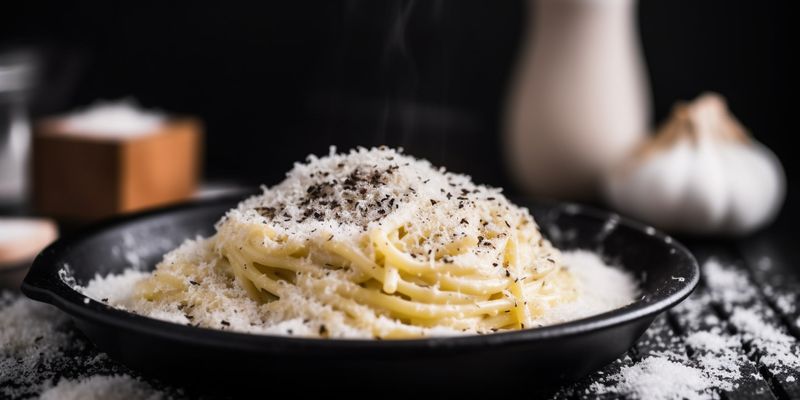Pasta with Broccoli Rabe: A Quick and Easy Italian Classic

Pasta with Broccoli Rabe is a classic Italian dish that is quick, easy, and delicious. This recipe is perfect for a weeknight dinner, as it can be prepared in just 30 minutes. Broccoli rabe, also known as rapini, is a leafy green vegetable that is a member of the broccoli family. It has a slightly bitter taste that pairs well with garlic and red pepper flakes.
Ingredients
- 1 pound pasta
- 1 bunch broccoli rabe
- 4 cloves garlic
- 1/2 teaspoon red pepper flakes
- 1/4 cup olive oil
- 1/2 cup grated Parmesan cheese
- Salt and pepper to taste
Instructions
-
Bring a large pot of salted water to a boil. Add the pasta and cook until al dente, according to package instructions. Drain and set aside.
-
While the pasta is cooking, trim the stems from the broccoli rabe and discard any tough or bruised leaves. Rinse the broccoli rabe well in cold water and shake dry.
-
In a large skillet, heat the olive oil over medium heat. Add the garlic and red pepper flakes and cook until fragrant, about 1 minute.
-
Add the broccoli rabe to the skillet and season with salt and pepper. Cook, stirring occasionally, until the broccoli rabe is wilted and tender, about 10 minutes.
-
Add the cooked pasta to the skillet and toss with the broccoli rabe and garlic oil. Sprinkle with Parmesan cheese and additional salt and pepper to taste. Serve hot.
Vegetarian/Vegan Version
To make a vegetarian version of this dish, simply omit the Parmesan cheese or use a vegan alternative. You can also substitute the pasta for a gluten-free or whole wheat option.
Variations
- Add cooked Italian sausage or sliced chicken for a heartier meal.
- Use kale or Swiss chard instead of broccoli rabe.
- Add chopped tomatoes or sundried tomatoes for a burst of flavor.
- Use different types of pasta, such as penne or linguine.
This Pasta with Broccoli Rabe recipe is a quick and easy way to enjoy a classic Italian dish. The combination of tender pasta, bitter broccoli rabe, and spicy garlic oil is sure to satisfy your taste buds. Whether you are a vegetarian or a meat lover, this dish can be customized to your liking. Give it a try and let us know what you think!
FAQ
What is Broccoli Rabe?
Broccoli Rabe is a bitter, leafy green vegetable. It is also known as rapini, and is commonly used in Italian cuisine.
Can I substitute Broccoli Rabe with regular broccoli?
No, Broccoli Rabe has a distinct flavor and texture that cannot be replicated with regular broccoli. However, you can substitute it with other bitter greens like kale or collard greens.
How do I prepare Broccoli Rabe for the recipe?
Trim the ends of the Broccoli Rabe and chop it into bite-sized pieces. Blanch it in boiling salted water for 2-3 minutes, then drain and rinse with cold water to stop the cooking process.
Can I use any type of pasta for this recipe?
Yes, you can use any type of pasta that you like. However, short pasta like penne or fusilli works best with this recipe as it can hold the sauce and broccoli rabe better.
Can I make this recipe vegan?
Yes, you can make this recipe vegan by omitting the cheese or using a vegan alternative.
Can I use frozen Broccoli Rabe?
No, it is not recommended to use frozen Broccoli Rabe for this recipe as it will become mushy when cooked.
Can I add meat to this recipe?
Yes, you can add meat like sausage or bacon to this recipe for added flavor. Cook the meat separately and add it to the pasta and Broccoli Rabe before serving.
Can I use canned broth instead of making it from scratch?
Yes, you can use canned broth instead of making it from scratch. However, homemade broth will provide more flavor and depth to the dish.
Can I make this recipe ahead of time?
Yes, you can make this recipe ahead of time and reheat it when ready to serve. However, the pasta may become slightly mushy when reheated.
Can I freeze this recipe?
No, it is not recommended to freeze this recipe as the Broccoli Rabe will become mushy when thawed. It is best to eat it fresh or store it in the refrigerator for up to 3 days.



